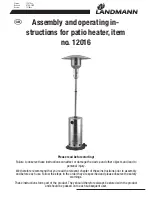
37
ONLY USE GENUINE HAYWARD REPLACEMENT PARTS
51300803801 REV B
Table 12: Water Chemistry
Chemical
Recommended
Level
Effect of Low Levels
Effect of High Levels
Chlorine
1 - 3 ppm
hazy water, algae growth, bacteria
causing infections
swimmer irritation, bleaching of clothes/
hair, corrosive to heat exchanger
Bromine
2 - 4 ppm
pH
7.4 - 7.6
corrosive to heat exchanger, swimmer
irritation
cloudy water, scaling of heat exchanger,
reduced sanitizer effectiveness
Total Alkalinity
80 - 120 ppm
corrosive to heat exchanger, large fluc-
tuations in pH
scaling of heat exchanger
Calcium
Hardness
200 - 400 ppm
corrosive to heat exchanger
scaling of heat exchanger
Salt
2700 - 5000 ppm
poor salt chlorinator performance
corrosive to heat exchanger
3.
SKIMMER CHLORINATION
: Placing chlorine or bromine Tablets directly into the skimmer may result in high chemical concentrations
flowing through the heater. DO NOT place chlorine or bromine Tablets in the skimmer.
4.
CHLORINATOR INSTALLATION
: Chlorinators must be installed downstream of the heater, and a check valve must be installed between
the heater and chlorinator to prevent high chemical concentrations from back flowing into the heater. Make sure your piping arrangement
meets the chlorinator installation requirements on page 23.
5.
BYPASS VALVE
: Bypass heater until water chemistry is properly balanced, so that corrosive and potentially damaging water will not flow
through the heater and therefore the heat exchanger. Close the bypass valve once the water is properly balanced.
WARNING:
BYPASS.
Failure to close the bypass valve when attempting to operate the heater will result in extensive damage to the
heat exchanger.
Ensure water flow through the heater is restored before operating the heater. A bypass feature is also advantageous for service needs and for
the ability to remove the heater from the water path when not heating.
WINTERIZATION:
In moderate climates, the heater can continue to operate during short-term cold spells. Do not use the heater to maintain the water tempera-
ture just above freezing or for freeze protection. Care must be taken to avoid freeze-up in the heater. When it is used during freezing weather,
the pump must run continuously. The heater is not warranted against freeze-ups. In regions where freezing temperatures are encountered, all
water must be drained from the heater when it is out of service to prevent damage to the heater and piping. Draining the heat exchanger is
recommended as part of the season’s shutdown procedures.
NOTICE:
A heater damaged by freezing is not covered under the manufacturer warranty.
DRAINING THE HEAT EXCHANGER:
This procedure applies to installations where the heater is located higher than the pool water level. If it
is necessary to drain a pool heater located below the pool water level, you must either partially drain the pool, or isolate the pool heater from
the pool using valves, then follow these steps.
1. Set the heater to STANDBY mode using the keypad.
2. Turn the electricity to the heater OFF at the circuit breaker panel.
3. Turn the heater gas valve OFF using the switch on the valve (see Figure 23).
4. Turn the heater’s gas supply OFF at the main shut-off valve outside the heater cabinet.
5. Be sure the circulating pump is OFF.
6. Remove the drain plug (see Figure 26).
7. Allow all water to drain from the heater.
8.
Re-install drain plug.








































